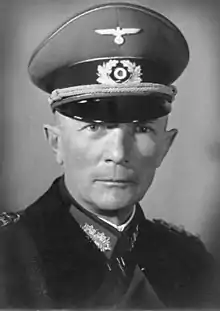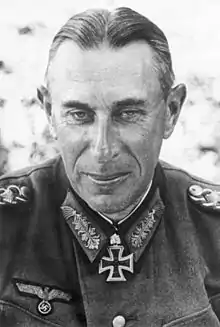2nd Army (Wehrmacht)
The 2nd Army (German: Armeeoberkommando 2) was a field army of the German Army during World War II.
| 2. Armee 2nd Army | |
|---|---|
 | |
| Active | 1939–1945 |
| Country | |
| Branch | Army |
| Type | Field army |
| Engagements | World War II |
| Commanders | |
| Notable commanders | |
History
1939 and 1940
The 2nd Army headquarters was briefly established in Berlin from Group Command 1 on 26 August 1939 and at the beginning of the Invasion of Poland it was renamed Army Group North on 2 September.[1]
The 2nd Army was reestablished on 20 October 1939, with Generaloberst Maximilian von Weichs in command, by renaming the 8th Army, which had been moved from Poland to the west. It was assigned to the reserve of the Oberkommando des Heeres (OKH). After the beginning of the Battle of France on 10 May, the army was assigned to Army Group A and marched through Luxembourg, Belgium, and northern France. From 31 May to 4 June it marched to the front north of the Somme, Aisne, and Oise and participated in the expansion of bridgeheads. When it entered battle on 9 June on the Aisne, the army included IX (295th and 294th Infantry Divisions), XXVI (34th and 45th Infantry Divisions), and VI Army Corps (205th, 15th, 293rd, and 5th Infantry Divisions). First seeing service in France, the army was involved in the invasion of the Balkans, before offensive operations in Ukraine as part of Operation Barbarossa.[1]
In 1942 the 2nd Army covered the northern wing of Case Blue operating in the surroundings of Voronezh. Generaloberst Hans von Salmuth became commander on 14 July.[1] It suffered a major defeat during the Voronezh-Kastornensk operation the Soviet winter offensive that followed the battle of Stalingrad. Generaloberst Walter Weiß became commander on 4 February 1943.[1]
General der Panzertruppe Dietrich von Saucken became commander of the army on 10 March 1945. The army was renamed Army East Prussia (AOK Ostpreußen) on 7 April and was pivotal in the defence of East and West Prussia before end of World War II in Europe on 9 May 1945.[1][2]
Commanders
| No. | Commander | Took office | Left office | Time in office | |
|---|---|---|---|---|---|
| 1 | Generaloberst Fedor von Bock (1880–1945) | 26 August 1939 | 2 September 1939 | 7 days | |
| 2 | Generaloberst Maximilian von Weichs (1881–1954) | 20 October 1939 | 15 November 1941 | 2 years, 26 days | |
| 3 | General der Panzertruppe Rudolf Schmidt (1886–1957) | 15 November 1941 | 15 January 1942 | 61 days | |
| (2) | Generaloberst Maximilian von Weichs (1881–1954) | 15 January 1942 | 14 July 1942 | 180 days | |
| 4 | Generaloberst Hans von Salmuth (1888–1962) | 15 July 1942 | 3 February 1943 | 203 days | |
| 5 | Generaloberst Walter Weiß (1890–1967) | 4 February 1943 | 9 March 1945 | 2 years, 33 days | |
| 6 | General der Panzertruppe Dietrich von Saucken (1892–1980) | 10 March 1945 | 7 April 1945 | 28 days |

See also
- 2nd Army (German Empire) for the equivalent formation in World War I
References
Citations
- Tessin 1973, pp. 83–88.
- Beevor, Antony. Berlin: The Downfall 1945, Penguin Books, 2002, ISBN 0-670-88695-5, pp.26, 49, 50, 88, 90, 115–116, 119, 402
- Nafziger, George. "German 2nd Army, Invasion of the Balkans, 1 April 1941" (PDF). The Nafziger Orders of Battle Collection. United States Army Combined Arms College. Retrieved 6 December 2015.
Bibliography
- Tessin, Georg (1973). Verbände und Truppen der deutschen Wehrmacht und Waffen-SS im Zweiten Weltkrieg 1939–1945 [Formations and Units of the German Wehrmacht and Waffen-SS in World War II, 1939–1945]. 2. Bissendorf: Biblio Verlag. ISBN 3-7648-0871-3.




.jpg.webp)
